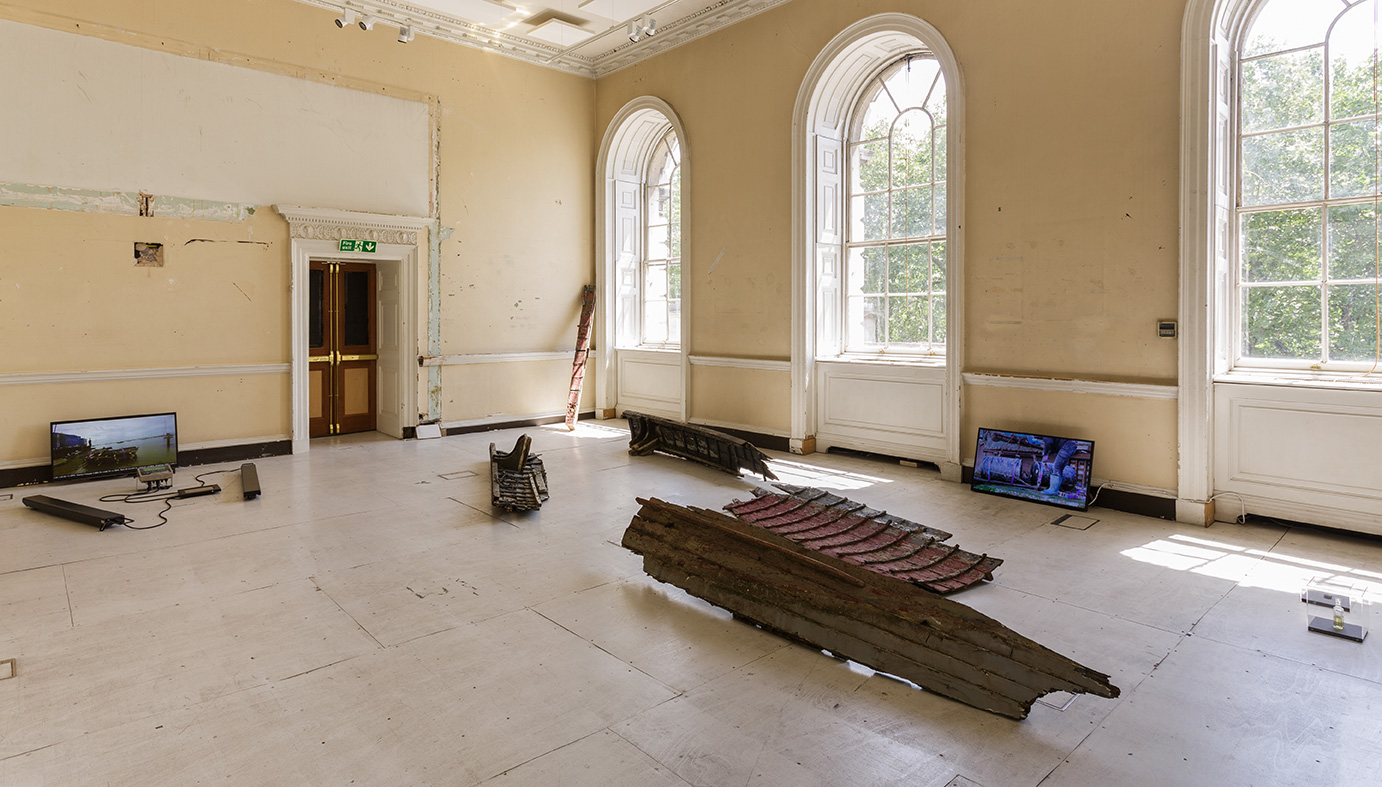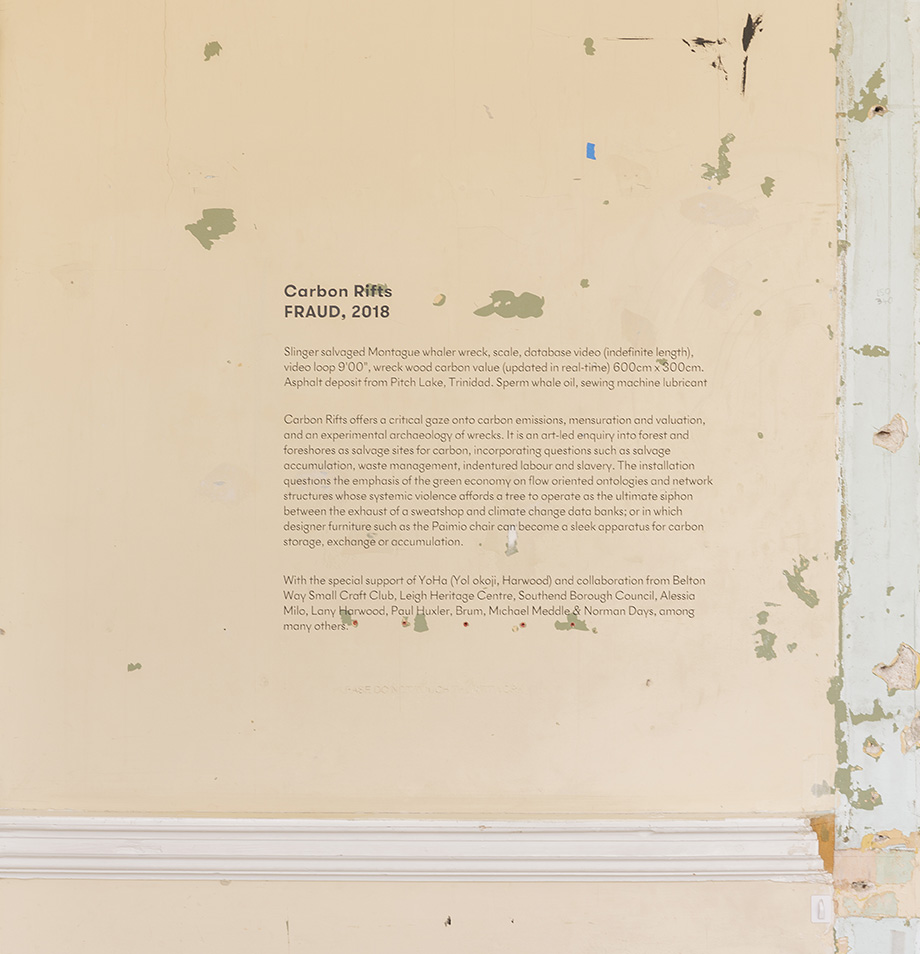Carbon Rifts is an offsite sunk-wood drying installation.
The process of salvaging wrecks unearths histories of the North Sea, colonialism, whaling, tar, shipbuilding, deforestation, carbon circulation and emission trading. The following documentation traces a genealogy of carbon derivatives. It is an interface into carbon emissions mensuration and valuation, and an experimental archaeology of wrecks. It is an art-led enquiry into forest and foreshores as salvage sites for the carbon market. Carbon rifts through resource extraction and accumulation, waste management, indentured and waged labour and value speculation. Savaging and salvaging practices such as forestry, life-saving, arboriculture, whale oil hunting, are fundamentally ambiguous in their operations. The inshore waters of the North Sea are one of the most productive regions in the world. They constitute one of the most important fishing grounds, as well as the most high-yielding offshore drilling region. It has been estimated that the English Channel produces annually 13 tons of organic matter per hectare. This figure is twice the yield than any meadow on the surrounding land on a good year. No timber harvest can come from the sand, brackish water disrupts growth in many plant roots. A strand might well be the antithesis of the garden, and yet it has never seen a scarcity of wood. More vessels have been wrecked and wasted on their shifting banks at any one time than circumnavigating its surface. Houses and cottages have cobbled clinker-built sides and curved mansard roofs out of old ship bits.
Construction of houses uses boat building techniques.
Global networks come together in salvaged material.
Scraps from the World Trade Center, demolished after the 9/11 attacks, were melted into the bow of the USS New York destroyer.
An architectural absentmindedness murks what belongs to the sea and to the land.
A coastline is nothing but ruins, the ocean an abyss full of debris.
Burying grounds: the arrival of Cristobal Columbus in Caribbean waters not only launched an unprecedented globalization era.
Syphilis, caused by bacterium Treponema pallidum, was one of many 'gifts' to American indigenous peoples.
T. pallidum infected 20 percent of the old world population via soldiers and sex workers.
Columbus' voyage also marked the arrival of shipwrecks to the world's west end.
The Santa Maria, the flagship of Colon's first voyage, run aground in 1492 in the north west coast of Haiti.
But in the North Sea, from the Tyne to the Thames, the East Anglian coast forms a large ship graveyard.
The Yorkshire and Lincolnshire beaches claimed large fleets of colliers staggering north in ballast, troubled in their homeward way, or deep-laden to foreign ports.
Crafts embayed in the Wash, or making an ill-judged landfall from the Baltic, left their wooden bones by the tonne on Norfolk’s humps.
Of all the shipping death-traps, none was more destructive than the sandbanks of the Thames Estuary.
The region’s topographical naming attests to the significance of its hazardous islands and coastlines.
Greenwich, Plumstead, Rainham, Dengie, Cliffe, St. Mary's Grain, The Isle of Dogs, Canvey Island, and The Dead's Men Island.
They are all names derived from bywords that stand for low lying, unstable regions, often treacherous, isolated and difficult of access.
Offshore equivalents are the Wash, the Shipwash, the Sunk bank, the Goodwins, or the Longsands.
The sea is "an immensity that receives no impress, preserves no memories, and keeps no reckoning of lives".
There have always been more vessels wasted on the ocean bed than circumnavigating its surface.
In 'Principles of Geology' (1832) Charles Lyell included an examination of the Lloyd's list of wrecks in England from 1793 to 1829 to show the material extent being deposited on the North Sea floors.
An approximate computation of sunk vessels lost to warfare, storms, shoals, mutiny.
Lee-shores—gave 550 crafts per year, or an average of 1.5 per day. Building an eighty-guns ship required two thousands tons of wood.
60 top rate ships of less than a 120 guns consumed a forest like Epping in Essex. With each wreck, 40 acres of oak forest sunk.
There was little distinction at that time between a merchant ship and a man-of-war.
It took 150 years for an oak tree to be considered mature for shipbuilding.
The smiling green of the pastoral might seem to offer safe refuge, standing out as the antithesis of the desolated mudflats along the North Sea.
In 2010, the Lloyd's register included a mere 100 000 shipwrecks.
There is more wood in the submerged forests than the standing ones on the British Island.
Zarathrusta’s warned "Don't go to mankind, but remain in the forest!".
We might well consider the voluptuous horizonals of the shore. The foreshore is a forest shore.
Forests once marked the limit of sovereignty, the areas of productive economy and, ultimately, the threshold of the law, civitas.
They became the frontier against which the metropolis was defined.
Descartes claimed forests were alienating, confusing spaces.
They stood as obstacles for the engineer's mind who longed for the modern vacant plain.
In forests the straight lines of geometry encounter the greatest obstacles.
The civic boundaries of cities offered, supposedly, refuge from the woodland's shadows.
Forests were in fact commonly referred to as locus neminis, or 'place of no one'.
The Latin word nemus, or woodlands, might come from nemo, meaning 'no one'.
The 'res nullius' stood against the 'res publica', and a sylvan fringe gave the civic space its natural boundaries.
The financialisation and valuation of forests can be seen as one of the foundations of western political power as much as its effacement.
Like navigation, forestry is intimately entangled with the history of colonization and war.
The harvesting of timbers for naval construction, and tar used to preserve and seal the hulls, were trades that created speculative riches and famine.
In medieval Europe, for financial gain, aristocracy placed restrictions on forest use to create scarcity.
The exhaustion of wood resources is considered an essential factor and incentive for the development of industrial capitalism.
The history of forests, oceans and financialisation is deeply entangled.
To fuel the colonial expansion, longleaf pines were in high demand to make masts.
They often were called "king's trees" reserved for making ships' masts.
The northern forests of Finland, Sweden and Canada fed the colonial enterprises undertook by European empires.
They provided pine logs for masts and pine tar to seal the hulls of ships.
Trees suitable for masting were difficult to find. Mast trees take a century to grow.
They were a crucial requirement for any sailing ship, and often had to be replaced after storms or wear.
Timber from pine trees was only a viable industry in sparsely populated areas.
As European powers competed on the high seas, higher, tougher and more robust masts were in increased demand.
They became the cutting edge of naval technology. Ships with huge single masts could travel at full sail.
Others with composite masts were slower and vulnerable to strong winds.
This is cited as one of the reasons why Britain outstripped France at sea in the C18th.
Equally important was pine tar used as wood preservative.
Finnish pine tar was reknowned as being the best (in quality and fabrication method).
Finland was one the most important providers of timber and tar for its European neighbours’ pillaging ventures abroad.
The American War of Independence increased the demand sharply.
The price fluctuation of the black gold is linked to both the creation of a bourgeoisie and great famines in Finland.
The increase of the value of timber afforded the switch from an agricultural to a monetary economy in Finland.
These changes were dubbed the ‘liberalization of Finland’ in the 1860s.
It coincided with the creation of the Finnish markka and the beginning of a widening gap between forest owners and landless peasants.
Europe’s colonial adventures also brought about an early instance of climate making history.
The mass-slaughtering of indigenous populations in the American continent afforded wild forest regrowth.
The dramatic reduction of atmospheric carbon dioxide brought a climatic anomaly of cooling effects.
This short-lived period of climate change in turn precipitated the worst attack against the female body.
The Little Ice Age constitutes the worst epoch of witch terror.
Bavarian and Swiss chronicles portrayed witches as weather makers.
Witches were blaimed for the hail and thunderstorms that damaged buildings, killed animals and destroyed crops and vineyards.
Essex was known as Witch County, between 1580 and 1690, 503 women were trialled for witchcraft.
Colonialism legitimated a worldview that collapsed women, land, and the 'uncivilized Other'.
The colonial project propelled by resource scarcity soon demanded a new fuel, whale oil.
Whalers or whaleboats like the Slinger on display in this exhibition have been more contemporaneously used as training boats for the Navy.
Their design is exactly the same to those used during the whaling trade.
It was an 8 metre long boat from which whales were harpooned, an open narrow, pointed at both ends.
Its design was such that all elements were stowed within itself: sails, masts, and tiller.
During the whale-age they were manned by a crew of six or seven.
Whaleboats were slung from whale-ships, often called 'cats' of 250-380 tons burthen.
'Burthen' was a measure of capacity derived by a mathematical formula computing the length and beam (breadth) in feet.
Whaleboats spent days even weeks in the hunt for whales, isolated from the main ship.
Whaleboats could be called heterotopias within. The term heterotopia originated in the field of medicine.
As term it referred to a particular tissue that develops at another place than is usual.
The tissue is not diseased or particularly dangerous but merely placed elsewhere, a dislocation.
Brothels, ships and colonies, are all forms of heterotopias. Heterotopias exist something like countersites.
Ships are a floating space without a place, that is closed on itself and at the same time is given over the infinity of the sea.
"From port to port, from tack to tack, from brothel to brothel" a ship travels in search of the most precious treasures.
Whales helped lay the foundations of the British Empire.
In many instances settlers at Botany Bay were saved from starvation by the timely arrival of whaling vessels.
Sperm whale oil or case oil is a straw colored wax unlikely to freeze even at sub-zero temperatures.
It resists extremely high pressure and still remains the ultimate lubricant.
Sperm whale oil also ruptured time ruled by the movement of the sun and the moon.
Lubricating the most precise watches and chronometers, whale oil introduced standard time, carving up continents into time zones.
Burning brightly and smokelessly in lighthouses, whale oil directed shipping trade away from sandbanks and escarpments.
Spermaceti oil was also used in all of Nasa's space missions.
The Hubble space telescope and the Voyager space probe are careening into infinity, oiled by whales.
Another byproduct of whales is the Whale Oil Myth used to defend the operations of free markets.
The myth goes that whales were saved because of the march of technology, or that kerosene saved the whales.
Canadian geologist Abraham Gesner devised a method for distilling kerosene from petroleum in 1849.
The myth aims to persuade us of the self-regulating nature of the market.
Though the petroleum industry was not facilitated by market conditions but rather by government intervention.
The petroleum industry is and has always been heavily subsidized.
In 1916, US Congress approved the expensing of equipment used or work done in the first year of a well’s life.
Today, the century-old tax break remains, by which oil companies can expense 70 percent of their drilling costs and depreciate the rest.
Annual cost to taxpayers: $700 million to $3.5 billion.
In the 1970s and 80s Walter Wriston, Ronald Reagan’s economic advisor, often used the Whale Oil Myth.
He used this parable to argue for the termination of all federal energy policy.
Ushered by deregulation, the market would point to the right direction.
Acting on this advice, Reagan crippled federal environmental regulation and energy research during the 1980s.
The whale oil myth wreckage continues today.
Many maritime archaeologist have described how shipwrecks have always attracted the attention of potential salvors.
The shore has operated since antiquity as the receptacle of the sea rejections.
It is along the strand that oceans purge themselves and throw up their monster.
One of the earliest practices of salvage accumulation was, in fact, salvaging.
Harwich and its neighbour Colneside became the centre of the salvaging trade.
Rescuer and salvager were always closely connected with the evolution of crafts capable of facing the conditions involved.
Among them there are whaler boats and cod smacks.
From the first gale in October until the end of March, hardly a week passed without a profitable opportunity.
Salvager risked death in profitable exploits to rescue half downed seamen from sunken ships.
The next day they headed back to strip the wreck of every rope yarn and crap of salvable cargo.
Salvaged wood was not taxed.
In C19 wrecks and salvage rights fell within under the remit of the Customs service and Lloyd's agents.
Civilization and progress have operated as cover-ups and translation mechanisms to get access to value through violence.
"Salvage accumulation" is the process through which lead firms amass capital without controlling the conditions under which commodities are produced.
Salvage accumulation, with its apparatus of translation, converts the black golds they dig into assets legible to capitalist business.
Unlike primitive accumulation, salvage is never complete.
It accounts for economic processes outside their control.
‘Salvage’ capitalism extends itself through supply chains that organize wildly diverse forms of work and nature into commensurate processes for capital.
Savage and salvage are often twins.
Industrial forestry also provides an estimate of 'worth' with the mathematization of risk calculation.
Industrial forestry conquers the uncertainty of time through planned harvest, determined maturity, yield calculation and other predictions.
Eino Saari (1894-1971), the founder of forest economics in Finland, pioneered the 1st national wood utilization survey in the world.
With it, forest valuation was born.
The development of biological-mensurational research applies economic theory and facts to biological and technical conceptions.
In 1966, the Finnish Forest Research Institute claimed that “the age of planned development of forest resources is about to begin”.
More contemporaneously forests are portrayed as a great cycle of carbon.
Its nominal abstractions are carbon circulation, exchange, or leakage.
For advance capitalism, forest are the space of carbon flows par excellence.
Capitalism privileges flow oriented activities and network structures.
The space of flows was theorised by Manuel Castells, described as "hyperspaces of pure circulation", fundamentally a-social and separated from everyday violence.
This model of flows obfuscates how the actual spaces of the circulation are often dismissed, insulated from social contestation.
Understanding forests as a space of flows for carbon obfuscates its cultural conflicts, subaltern knowledges and environmental violence.
Disguised under a screen of derivatives.
Such abstraction of forests paves the way for their instrumentalisation in financial valuation and exchange.
The carbon market is projected to become the world’s largest commodity market by 2020.
The carbon market is the largest sector of investment internationally.
Putting a price on nature was imagined to help curb climate change.
Essentially each country receives an allotment of credits that they distribute to industries.
If an industry polutes more than its alloted portion, it must purchase credits.
The incentive to reduce emissions produced by the industry is financial.
This is how it operates in theory, in practice the implementation has been rather slippery.
Fundamental to the function of the emission trading system on which the carbon market is based is the notion of carbon leakage.
Carbon leakage is a projected phenomena resulting from the imagined consequence of stringent climate policies.
In other words, companies moving their production abroad to countries with less ambitious climate measures.
Thus, manufacturing industries that are deemed at risk of carbon leakage receive their emission allocations for free.
In addition, industrial sectors are receiving more free pollution permits than the amount of CO2 they emit.
They then sell them, incurring what is called windfall profits.
Carbon–intensive industries gain billions in windfall profits, a substantial transfer of money from taxpayers to industry.
Market speculation drives the cost of carbon credits, intended to save what it abstracts...
Abstracting the northern forests in this way, like oceans, obscures and effaces the politics of their ongoing material construction (and reproduction).
Forests and oceans are not merely unfortunate spaces of carbon movement, divorced of social factors and conflicts.
We might be under the spell of the bio-economy.
In which a tree is the ultimate siphon between the chimney of a sweatshop and the IPCC (Intergovernmental Panel in Climate Change) database.
In which the sleek design of the Paimio chair can function as an apparatus for carbon storage.
We explore forest and foreshores as salvage sites for the carbon market.
Carbon rifts through resource extraction and accumulation, waste management, indentured and waged labour and value speculation.
Shipwrights in Liverpool were often themselves slave traders.
They perfected the two-masted clippers of sharp hull lines, with a V-shaped cross section below the waterline and and strongly raked stem, stern posts, and masts.
These clippers were small fast sailing vessels constructed to accommodate low-density, high value perishable cargo with speed to reduce mortality.
The full-rigged ship was the essential technology that enabled the trans-Atlantic slave trade to flourish.
Between 1698 and 1807 around 11,000 ships were fitted out in England for the slave trade.
They were often called Guineamen because they transported around three million West Africans from Guinea.
An English coin, the guinea, rare though it was, had its origin in the slave trade to Africa.
All gold imported from Africa by the Royal Company was coined by machine with an elephant on one side.
They were originally worth one pound sterling.
The finantialisation of humans, forests and whales lies in these wrecks. Still trading to the lowest bidder.




